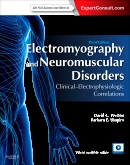New to This Edition
Ensure correct EMG needle placement and avoid neurovascular injuries by referring to more than 65 detailed, cross-
sectional anatomy drawings.
Diagnose many newly defined genetic neuromuscular conditions based on their electrodiagnostic presentation.
Stay up to date with must-know information on iatrogenic complications of electrodiagnostic studies.
Visualize key concepts more easily with a brand-new full-color design, new artwork, and new photographs.
Access Electromyography and Neuromuscular Disorders online, fully searchable, at www.expertconsult.com, along with more
than 70 videos that allow you to see and hear the EMG waveforms discussed in the text, as well as a convenient "test
yourself" module.
Key Features
Successfully correlate electrodiagnostic findings with key clinical findings for more confident diagnoses.
Clearly see how to apply what you've learned with abundant case studies throughout the book.
Obtain relevant clinical guidance quickly and easily with an accessible, easy-to-read writing style that's both
comprehensive and easy to understand.
Table of Contents
I. Overview of Nerve Conduction Studies and Electromyography
1. Approach to Nerve Conduction Studies and Electromyography
2. Anatomy and Neurophysiology
II. Fundamentals of Nerve Conduction Studies
3. Basic Nerve Conduction Studies
4. Late Responses
5. Blink Reflex
6. Repetitive Nerve Stimulation
III. Sources of Error: Anomalies, Artifacts, Technical Factors and Statistics
7. Anomalous Innervations
8. Artifacts and Technical Factors
9. Basic Statistics for Electrodiagnostic Studies
IV. Detailed Nerve Conduction Studies
10. Routine Upper Extremity, Facial and Phrenic Nerve Conduction Techniques
11. Routine Lower Extremity Nerve Conduction Studies
V. Fundamentals of Electromyography
12. Basic Overview of Electromyography
13. Anatomy for Needle Electromyography
14. Basic Electromyography: Analysis of Spontaneous Activity
15. Basic Electromyography: Analysis of Motor Unit Action Potentials
VI. Clinical-Electrophysiologic Correlations
16. Clinical-Electrophysiologic Correlations: Overview and Common Patterns
Part 1. Common Mononeuropathies
17. Median Neuropathy at the Wrist
18. Proximal Median Neuropathy
19. Ulnar Neuropathy at the Elbow
20. Ulnar Neuropathy at the Wrist
21. Radial Neuropathy
22. Peroneal Neuropathy
23. Femoral Neuropathy
24. Tarsal Tunnel Syndrome
25. Facial and Trigeminal Neuropathy
Part 2. Polyneuropathy
26. Polyneuropathy
Part 3. Motor Neuron Disease
27. Amyotrophic Lateral Sclerosis and its Variants
28. Atypical Motor Neuron Diseases
Part 4. Radiculopathy, Plexopathies and Proximal Neuropathies
29. Radiculopathy
30. Brachial Plexopathy
31. Proximal Neuropathies of the Shoulder and Arm
32. Lumbosacral Plexopathy
33. Sciatic Neuropathy
Part 5. Disorders of Neuromuscular Junction and Muscle
34. Neuromuscular Junction Disorders
35. Myopathy
36. Myotonic Muscle Disorders and Periodic Paralysis Syndromes
VII. Electromyography In Special Clinical Settings
37. Approach to Electrodiagnostic Studies in the Intensive Care Unit
38. Approach to Pediatric Electromyography
VIII. Electronics and Instrumentation
39. Basis of Electricity and Electronics for Electrodiagnostic Studies
40. Electrical Safety and Iatrogenic Complications of Electrodiagnostic Studies


